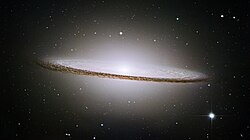Файл:Sombrero Galaxy in infrared light (Hubble Space Telescope and Spitzer Space Telescope).jpg

Розмір при попередньому перегляді: 800 × 448 пікселів. Інші роздільності: 320 × 179 пікселів | 640 × 359 пікселів | 1024 × 574 пікселів | 1280 × 717 пікселів | 3000 × 1681 пікселів.
Повна роздільність (3000 × 1681 пікселів, розмір файлу: 3,98 МБ, MIME-тип: image/jpeg)
Історія файлу
Клацніть на дату/час, щоб переглянути, як тоді виглядав файл.
| Дата/час | Мініатюра | Розмір об'єкта | Користувач | Коментар | |
|---|---|---|---|---|---|
| поточний | 20:46, 20 липня 2009 |  | 3000 × 1681 (3,98 МБ) | Tryphon | {{Information |Description=NASA/ESA Hubble Space Telescope and NASA's Spitzer Space Telescope joined forces to create this striking composite image of one of the most popular sights in the universe. Messier 104 is commonly known as the Sombrero galaxy bec |
Використання файлу
Така сторінка використовує цей файл:
Глобальне використання файлу
Цей файл використовують такі інші вікі:
- Використання в ast.wikipedia.org
- Використання в az.wikipedia.org
- Використання в bs.wikipedia.org
- Використання в cs.wikipedia.org
- Використання в de.wikipedia.org
- Використання в en.wikipedia.org
- Використання в en.wikiquote.org
- Використання в en.wikiversity.org
- Використання в es.wikipedia.org
- Використання в fa.wikipedia.org
- Використання в frp.wikipedia.org
- Використання в fr.wikipedia.org
- Використання в he.wikipedia.org
- Використання в id.wikipedia.org
- Використання в it.wikibooks.org
- Використання в kk.wikipedia.org
- Використання в kn.wikipedia.org
- Використання в mg.wikipedia.org
- Використання в pl.wikipedia.org
- Використання в pt.wikipedia.org
- Використання в simple.wikipedia.org
- Використання в sk.wikipedia.org
Переглянути сторінку глобального використання цього файлу.


